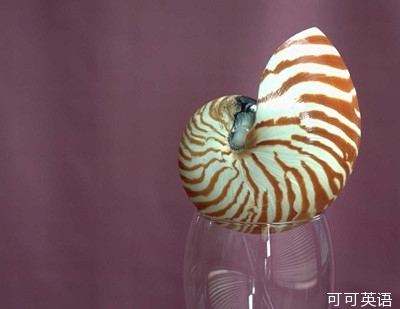Science and technology
科學(xué)技術(shù)
Palaeontology
古生物學(xué)
Remember the tooth
牙齒的痕跡
A link is made in an ancient ecosystem
古代生態(tài)系統(tǒng)中的線索
WHO ate whom in the food chains of the past is rarely clear.
在古代誰以吃誰為生是不清楚的。
Though it is obvious which species were predators and which prey,
盡管誰是捕食者和誰是獵物是很明顯的,
the subtle specialisations of feeding habit that allow many types of carnivore to co-exist are rarely preserved in the fossil record.
但是專門的微妙的捕食習(xí)慣,能讓多種食肉動物能夠共存的資料很少有保存完好的化石記錄。
 Rarely, but not never.
Rarely, but not never.
很少有記錄不表示沒有。
That is why the recent discovery of a Jurassic ammonite with a shark's tooth embedded in its shell has excited palaeontologists.
這就是為什么最近發(fā)現(xiàn)侏羅紀(jì)菊石,連同殼上面的鯊魚牙齒讓古生物學(xué)家非常興奮。
The ammonite in question, Orthaspidoceras, a species that thrived 155m years ago,
發(fā)現(xiàn)的鸚鵡螺是一種叫Orthaspidoceras的生活在一億五千五百萬年前的生物,
was part of the collection of an amateur who did not realise the significance of what he had found.
化石是由業(yè)余愛好者收藏的,他沒有意識到他發(fā)現(xiàn)的化石的意義。
Romain Vullo of the University of Rennes, however,
法國雷恩大學(xué)的Romain Vullo卻明白,
did-and he has brought the discovery to the attention of the scientific world in the pages of Naturwissenschaften.
而他在《自然科學(xué)》雜志上的幾頁論文吸引了科學(xué)界的注意。
Ammonites were both predators and prey.
鸚鵡螺既是捕食者也是獵物。
They occupied a position in the Mesozoic oceans similar to that of modern squid.
他們生活在中生代的海洋中,跟現(xiàn)代烏賊相似。
Like squid, they were swimming tentacled molluscs-a group called the cephalopods.
跟烏賊一樣,鸚鵡螺是游動的有觸須的軟體動物,屬于頭足綱動物。
Unlike squid, though, they had protective shells.
不像烏賊,鸚鵡螺有保護(hù)殼。
These shells were divided internally into gas-filled chambers.
這些保護(hù)殼的里面有充滿氣體的分隔小室。
The result had neutral buoyancy, allowing the animal to move by jet propulsion.
結(jié)果就是鸚鵡螺有浮力,讓其像噴氣發(fā)動機推進(jìn)一樣的運動,這點跟烏賊一樣。
Modern pearly nautiluses, whose relationship to ammonites is much debated, have a similar arrangement.
現(xiàn)代珍珠一樣的鸚鵡螺跟遠(yuǎn)古鸚鵡螺的親緣關(guān)系盡管還有待驗證,但是現(xiàn)代鸚鵡螺也有類似的充氣推進(jìn)機制。
What ammonites-or, at least, some of them-ate became clear earlier this year when an X-ray showed a small crustacean in the jaws of a species called Baculites.
鸚鵡螺吃什么的問題今年有了答案,x光顯示桿鸚鵡螺的咽喉中有小甲殼類動物的痕跡。
But what ate ammonites has never been shown in such an unambiguous manner.
但是什么吃鸚鵡螺從來沒有像現(xiàn)在一樣模棱兩可。
Some ammonite fossils have tooth marks that look as though they were made by huge reptilian predators called mosasaurs.
一些鸚鵡螺化石上有牙印,看上去仿佛是巨大爬蟲類捕食者比如滄龍留下的。
Some appear to have been attacked by the beaks of other cephalopods.
有些牙印似乎是被其他頭足綱攻擊的痕跡。
And some seem to have been bitten by sharks.
有些牙印似乎是鯊魚留下的。
On top of that, coprolites, as palaeontologists politely describe fossil faeces, have turned up with ammonite shells in them.
最重要的是,對古生物學(xué)家禮貌地描述中的糞化石的研究表明,有些糞便中有鸚鵡螺的殼。
Based on comparisons with modern evacua, these are probably from sharks.
隨著現(xiàn)代技術(shù)的發(fā)展,研究表明這些糞便來自于鯊魚。
But which sharks?
但是哪種鯊魚吃鸚鵡螺呢?
Dr Vullo's ammonite nails one culprit.
Vullo博士的化石標(biāo)本確定了其中的一個罪魁禍?zhǔn)住?/div>
The tooth belongs to a species called Planohybodus.
化石中鸚鵡螺外殼上的牙齒屬于一種叫做平弓鯊的物種。
And that is a surprise. Those modern sharks that eat shelled animals have robust teeth for crunching through hard exteriors.
這是一個驚喜的發(fā)現(xiàn)。覓食有殼動物的現(xiàn)代鯊魚通常長著強壯的牙齒,可以咬穿堅硬的外殼。
The teeth of Planohybodus, in contrast, were slender and pointed-the sort usually associated with grasping and tearing at flesh.
相反,平弓鯊的牙齒,是那種纖細(xì)而突出的,一般讓人聯(lián)想到抓住和撕裂肉。
In a modern predator, that would indicate the habit of eating fish.
在現(xiàn)代掠食者中,擁有這種牙齒意味著習(xí)慣吃魚。
That a shark with teeth like this would try to make a meal of an ammonite is, at first sight, odd.
長著這樣牙齒的鯊魚,會試圖吃掉鸚鵡螺,美餐一頓的理論,乍一看有點古怪。
But second thoughts provide a possible explanation.
但想一想就有了合理的解釋。
Ammonites' manoeuvrability would have depended crucially on their buoyancy control.
鸚鵡螺的靈活性主要建立在浮力控制上面的。
Even a small puncture to the shell, which a pointed tooth would be well able to deliver,
即使是殼上的一個小洞,可能就是這樣尖牙造成的,就會讓水進(jìn)入殼內(nèi),
would let the water in and cause that control to vanish.
鸚鵡螺從而無法控制浮力。
Since ammonites could not withdraw entirely into their shells for self-defence,
鸚鵡螺不能完全縮回外殼內(nèi)自衛(wèi),
it would then just be a question of dragging the creature out of its chamber in order to eat it.
于是就很可能就會被從外殼中拽出,成了其他生物的美食。
And for that, sharp, pointed teeth are ideal.
這樣說來,鋒利的尖牙是完美的武器。











